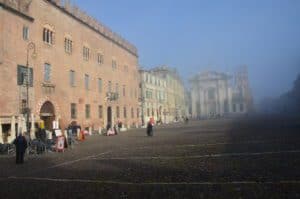Last updated on .
Mantua (also Mantova), a UNESCO World Heritage site, is one of the important cultural cities in northern Italy. Lovers of the arts will be impressed by what the city has to offer.
History
Mantua was founded by the Etruscans. The Roman poet Virgil was born nearby. After Roman rule ended, Mantua changed hands several times and was a free city for a short time. As a free city, four artificial lakes were created starting in 1198 to improve the city’s natural defenses. Three of the lakes remain today.
No rulers had more impact than the Gonzaga family, who took over in 1328. The Gonzaga rulers built opulent palaces such as Palazzo Te and the Ducal Palace as well as important churches. They were protectors of the arts and culture which is why Mantua is an important center of Renaissance art today.
After the Gonzaga family line came to an end in 1708, the Habsburgs of Austria took over. They ruled until the city unified with Italy in 1866, but their rule was broken with brief spells of French control.

Getting There
We visited Mantua on a day trip from Verona. The train took about 45 minutes and arrived at the Mantua Railway Station, which opened in 1873. It’s a small station with a café. Other than Verona, it’s possible to get direct service to other cities such as Milan, Rome, Florence, Bologna, and Modena.
Getting Around
Mantua is small enough to get around on foot. We walked from the train station to the historic city center in about five minutes. If you’re going to Palazzo Te, you can walk there in about 15 or 20 minutes from the city center. We only used a taxi once, when we left Palazzo Te to go to the train station.
Mantova Card
For just €25 (as of August 2023), the Mantova Card gives free admission to the most important sites in Mantua, including the Ducal Palace and Palazzo Te, Bibiena Theatre, and more. It also gives free admission to all museums in the city of Sabbioneta and includes unlimited use of city buses and the intercity bus from Mantua to Sabbioneta. It’s a great deal if you plan on visiting several museums and palaces. The card is valid for 72 hours.
Caffè Mirò
We had a quick coffee at Caffè Mirò, opposite Basilica of Sant’Andrea on Piazza Andrea Mantegna. The coffee was so-so and the service was cold.
Osteria dei Commensali
For lunch, we were greeted by a very friendly man and shown the menu to Osteria dei Commensali on Piazza delle Erbe. Everything looked good so we gave it a shot. The prices seemed a bit high but the food was good. Service, however, was lacking. I had a pizza while Marisol had ravioli.